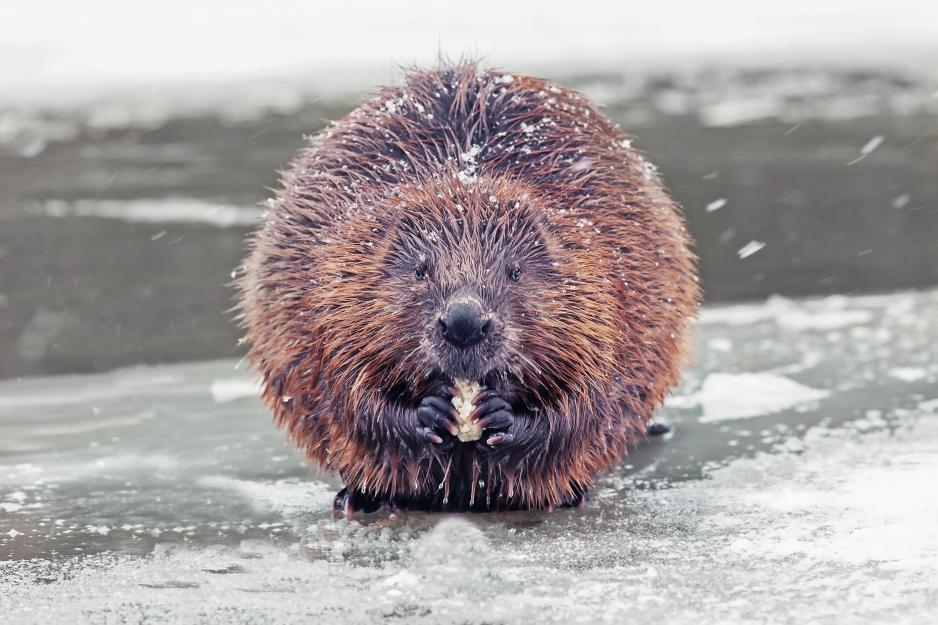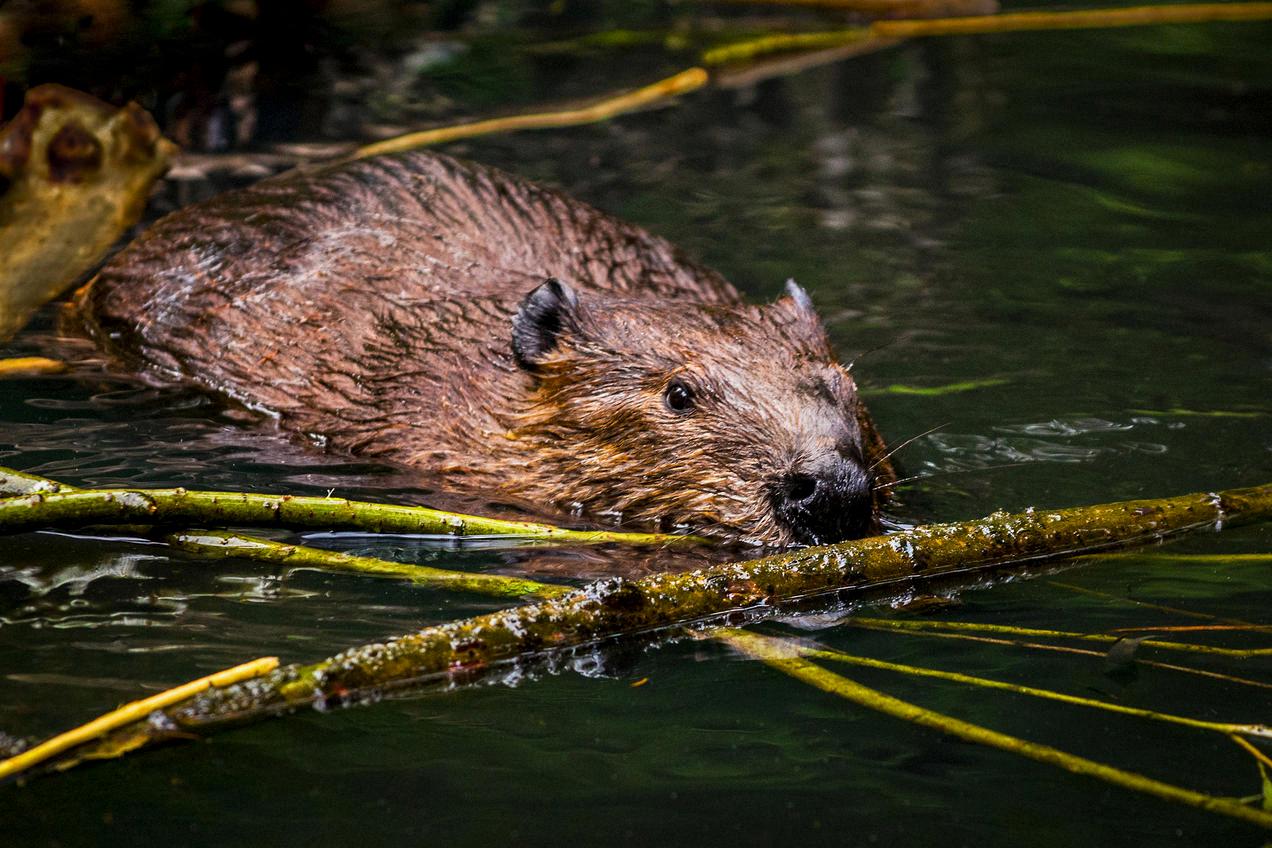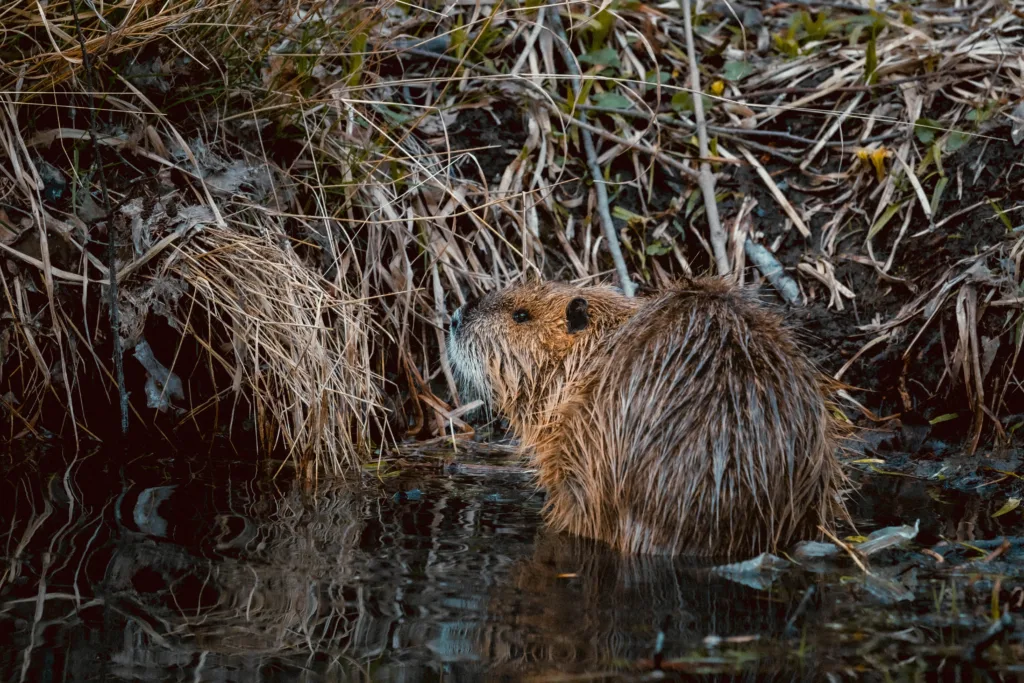Beavers are fascinating creatures that are known for their incredible ability to build dams and lodges. As winter approaches, many people wonder if beavers hibernate like other animals. The answer is no, beavers do not hibernate during the winter months.
In fact, beavers remain active and awake throughout the entire winter season. However, they do take measures to ensure that they are protected from the harsh winter weather. Beavers put on body fat during the fall, which provides insulation as well as stored energy. Their tails are designed to store fat and shrink in size over the winter as the fat is used up. Additionally, beavers have thick fur that insulates them from the cold.
Beavers spend the entire winter inside their lodges, which are sturdily built of logs, rocks, grass, and mud. These lodges can stay standing and in use for many years. Before their ponds freeze, the beavers store food (fresh branches) in the water around their lodges. It’s important to note that the entrance to a beaver lodge is under the water.
During the winter months, a beaver will swim out of the lodge to get food under the ice. They use their powerful front teeth to cut through the ice and access the branches they stored earlier in the season. Beavers are also able to hold their breath for up to 15 minutes, which allows them to swim underwater for long periods of time.
While beavers do not hibernate, they do spend the majority of their time inside their lodges. In the fall, they build up a supply of food and prepare their lodges for the winter season. The lodges they build for living, while mostly submerged, have a large dry room that is aove water that serves as their den. This main room is insulated with sticks and mud, and it remains much warmer than the water or outside air.
Beavers do not hibernate during the winter months. Instead, they remain active and awake while taking steps to protect themselves from the harsh winter weather. Their lodges provide a warm and safe environment for them to spend the winter season. Beavers are truly amazing animals and their ability to adapt to their environment is truly remarkable.
How Do Beavers Survive Winter?
During winter, beavers retreat to their lodges, which are complex structures made of logs, rocks, grass, and mud. Unlike many other animals, beavers do not hibernate during the winter months. They remain active and awake in their lodges throughout the entire season. To survive the cold temperatures, beavers store food, such as branches and twigs, in their lodges before the water freezes. They also use their thick, waterproof fur to keep warm. The lodges themselves are designed to provide insulation and warmth, with multiple chambers that trap air and retain heat. Overall, beavers are adapted to survive the harsh winter conditions, and their lodges provide a cozy retreat where they can stay warm and active until spring arrives.

Survival Strategies of Beavers in Cold Climates
Beavers are well adapted to survive the cold weather. During the fall, they put on body fat, which serves as insulation as well as a source of stored energy. The beaver’s tail is specifically designed to store fat and shrinks in size over the winter as the fat is used up. This is a crucial adaptation as the beaver’s tail is essential to its survival. Thick fur also plays an important role in insulating the beaver’s body from the cold. Beavers have two different types of fur: a thick undercoat and longer guard hairs. The undercoat traps a layer of warm air next to their skin, while the guard hairs repel water and snow. The combination of these two types of fur helps to keep the beaver warm and dry in the cold winter months. Additionally, beavers build dams and lodges to provide further insulation from the cold. These structures are made from branches, sticks, and mud, which create a dense barrier againt the elements. Overall, the combination of body fat, thick fur, and shelter enables beavers to survive the cold and harsh winter months.
How Do Beavers Adapt to Frozen Water?
When the water freezes, beavers retreat to their lodges and spend the entire winter inside. However, before their ponds freeze, they store food (fresh branches) in the water around their lodges. This is because the entrance to a beaver lodge is under the water, and it would be difficult for them to get food once the water is frozen. During the winter, when they need to eat, beavers swim out of their lodges and dive under the ice to retrieve the stored branches. They are able to hold their breath for up to 15 minutes and can swim up to half a mile underwater. This strategy allws the beavers to survive the winter months without having to leave their lodges.
Do Beavers Hibernate?
Beavers do not hibernate in the winter. Instead, they have developed unique adaptations to survive the cold temperatures. They build lodges that are mostly submerged in water, but also have a dry room above the waterline that serves as their den. This main room is insulated with sticks and mud, which helps to keep it much warmer than the water or outside air. Beavers also store food for the winter, such as branches, twigs, and bark, which they access by swimming under the ice. This allows them to conserve energy and survive the winter without hibernating.
Lifespan of a Beaver
The lifespan of a North American beaver is typically 10 to 12 years. However, there have been cases of beavers living longer in human care. In fact, the oldest recorded beaver lived to be 30 years old. It is important to note that factors such as habitat, food availability, and predators can all impact the lifespan of a beaver in the wild. Nevertheless, on average, a beaver can be expected to live for a decade or so.

Source: nrdc.org
Are Beavers Friendly?
Beavers are not considered to be friendly or unfriendly towards humans. They are, in fact, generally indifferent to human presence. As aquatic rodents, their primary focus is on building and maintaining their dams and lodges, as well as foraging for food. While they may occasionally interact with humans or othr animals, they do not view them as either friends or foes. It is important to note, however, that beavers can become aggressive if they feel threatened, particularly if they are protecting their young or their territory. Therefore, it is best to maintain a safe distance from these animals and observe them from afar, rather than attempting to approach or interact with them.
Leading Cause of Death in Beavers
The leading cause of death in beavers can vary depending on the species and environment they inhabit. However, in general, infections and diseases remain the dominant natural causes of death. Beavers are susceptible to various bacterial, viral, and fungal infections, which can cause inflammations and damage to ther internal organs. In addition, environmental factors such as pollution and habitat destruction can weaken their immune system, making them more vulnerable to infections. Predation and accidents, such as getting caught in traps or hit by vehicles, are also common causes of death in beavers. Overall, it is important to understand and address the various factors that contribute to the mortality of beavers, in order to ensure their survival and well-being in the wild.
Leading Cause of Death in Beavers
Beavers are not commonly studied in relation to mortality rates. However, if we consider the factors that can lead to the death of a beaver, it can be caused by natural predators such as wolves, bears, and coyotes. Additionally, diseases and infections can also pose a threat to their survival. Human activities such as hunting, trapping, or habitat destruction can also contribute to their decline. It is essential to keep in mind that beavers play a crucial role in maintaining the health of wetland ecosystems, and conservation efforts shold be taken to ensure their survival.
Beavers and Fear: What Are They Afraid Of?
Beavers are generally afraid of predators such as wolves, coyotes, and bears. They also have a natural fear of humans, which is why they tend to build their dams and lodges in secluded areas away from human activity. However, beavers are typically not afraid of oter animals that do not pose a direct threat to them, such as deer or birds. As for specific repellents, while there are many products on the market that claim to repel beavers, most pest removal experts say that they are not very effective. Therefore, it’s best to focus on prevention methods such as installing fencing or wire mesh around trees and other vegetation that beavers may target for dam building.

The Meaning of a Beaver Slapping the Water
When a beaver slaps its tail against the water, it is a warning signal to other members of its family. This behavior is used to communicate the presence of danger, such as a predator or a perceived threat from another beaver family. The sound created by the tail slap is quite loud and can be heard from a distance, which makes it an effective way for beavers to alert their family members of any potential danger. Overall, tail slapping is an important communication tool that beavers use to protect themselves and their families in their territorial environment.
What Is the Name of a Female Beaver?
A female beaver is simply called a “female” or a “she-beaver”. Unlike some animal species that have specific names for males and females, beavers do not have any such distinct names. However, it is worth noting that beavers have a unique and complex social structure where both males and females play important roles in building and maintaining their dams and lodges. Additionally, female beavers are responsible for carrying and raising their young, which are called kits.
The Activity of Beavers During Different Months
Beavers are active year-round, and their level of activity does not seem to vary significantly by season. They are primarily nocturnal, which means they are more active during the night than the day. However, they can sometimes be seen during the daytime as well. Their activity is usually concentrated around their lodges and dams, but they may travel several hundred feet from the water in search of food and materials for maintenance purposes. Therefore, there is no particular month when beavers are most active, as their activity levels remain relatively constant throughout the year.
Are Beavers Nocturnal?
Yes, beavers are mostly active at night. They are nocturnal animals which means they are most active during the night and sleep during the day. However, it is not uncommon to see beavers during the day. They usually live in “families” consisting of parents, yearlings, and kits and occupy a lodge. The beavers work on building and maintaining their lodges during the day and go out at night to gather food and materials. So, although they are active during the night, they still do some activities during the day as well.

Where Do Beavers Spend Their Days?
Beavers are semi-aquatic rodents that live in a variety of freshwater habitats throughout North America. During the day, beavers can typically be found in or near teir lodges, which are dome-shaped structures made of sticks, mud, and other materials. These lodges serve as their homes, providing shelter from predators and harsh weather conditions. In addition to their lodges, beavers also spend a significant amount of time near bodies of water, such as ponds, lakes, rivers, marshes, and streams. This is because they need a constant source of water to survive and to build and maintain their dams, which regulate the water flow in their habitats. Overall, beavers are very busy creatures and spend most of their day searching for food and building materials for their homes and dams.
Do Beavers Roam At Night?
Yes, beavers are primarily nocturnal animals, whih means they are most active during the night. They carry out most of their activities, such as building their dams and lodges and obtaining food, from dusk to dawn. However, they are not strictly nocturnal and may also be active during the day, especially during the spring and summer months. During the winter season, beavers do not hibernate but instead regularly leave their lodges to obtain food from a submerged stash. This stash is typically anchored nearby below the frozen surface. Overall, beavers are well adapted to a nocturnal lifestyle and are most active at night.
Conclusion
In conclusion, beavers are not true hibernators and remain active thoughout the winter months. They build sturdy lodges made of logs, rocks, grass, and mud to protect themselves from the cold and store food in the water around their lodges before the ponds freeze. Beavers put on body fat during the fall, providing insulation as well as stored energy. Their thick fur also helps to insulate them from the cold. Although they spend the entire winter inside their lodges, they swim out to get food under the ice. The main room of their lodge is insulated with sticks and mud, keeping them much warmer than the water or outside air. Therefore, beavers do not hibernate in the winter, but instead, they adapt to the cold climate by staying active and building cozy lodges to survive the harsh winter months.
